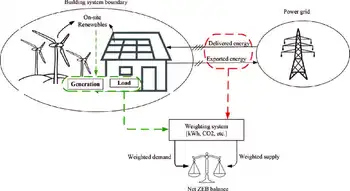Putting a pricetag on emissions
ItÂ’s not a technological fix from some solar-cell laboratory in Silicon Valley or wind-turbine researcher in Colorado or the development of some superbug to turn wood waste into ethanol.
Rather, the change would come from Washington, if Congress does what it has talked about and puts a price tag on greenhouse-gas emissions. Suddenly the carbon content of fuel, or how much carbon dioxide is produced per unit of energy, would be as important as what the fuel costs. In fact, it might largely define what the fuel costs.
That could shake up the economics of energy, handicapping some fuels and favoring others. Those that produce hefty emissions, like coal and oil, would likely look much worse. And some — sunlight, wind, uranium, even corn stalks and trash as well as natural gas — would probably look much better. “Carbon-negative” fuels that take carbon dioxide out of the atmosphere as they are made, might even become feasible.
Carbon dioxide is what economists call an “externality,” something that imposes a cost on somebody other than the manufacturer. At some point, the thinking goes, Congress will force industries to pay those costs, either with a tax or a cap-and-trade system in which allowances will cost money. The consensus in the energy business is that lawmakers will come up with a charge that could start at $10 per metric ton or more.
On Thursday, a Senate subcommittee approved a bill to establish a cap-and-trade system for carbon dioxide, and the Democratic leadership is eager to have the Senate pass it by yearÂ’s end. But prospects in the House are less certain.
Still, with all the talk about a carbon charge, “your perspective shifts,” said Revis James, an economist at the Electric Power Research Institute, a nonprofit utility consortium in Palo Alto, Calif. “We’re definitely going to be paying a bill here for wanting to reduce these emissions.”
Some companies are already counting on paying such a bill. In October, NRG, an electric company in Princeton, N.J., made the first application in three decades for permission to build a nuclear power plant. In an interview, the chairman, David Crane, said his calculations showed that such a plant would be cost effective if the price of carbon dioxide emissions ran into “double digits” per ton.
The Electric Power Research InstituteÂ’s staff estimates the effect of a charge on carbon dioxide emissions on the price of a kilowatt-hour, the amount of electricity needed to run 10 100-watt bulbs for an hour. Natural gas produces 0.84 pounds of carbon dioxide per kilowatt-hour, and coal produces more than twice as much, 1.9 pounds.
At $10 per metric ton, the impact is minimal. But at $50 a ton, for example, the cost of a kilowatt-hour produced by coal goes from about 5.7 cents to about 10 cents. Wind power currently isnÂ’t competitive, according to the instituteÂ’s calculation, but it becomes competitive when carbon dioxide costs $25 a ton. By their calculations, nuclear energy, with negligible carbon dioxide emissions, looks sensible at a small carbon charge.
HereÂ’s how the new economics might work for solar power, according to Charles F. Gay, the vice president and general manager of solar business at Applied Materials, a California semiconductor company that has branched into that field.
Solar power from photovoltaic cells is very expensive, about 25 to 30 cents per kilowatt-hour. But compare a kilowatt-hour produced by such cells, which emit no carbon dioxide, with one produced by a conventional coal plant. At $20 or $30 a ton, the 1.9 pounds of carbon dioxide emitted in producing that kilowatt-hour costs 2 to 3 cents. That cuts into coal’s price advantage and — when coupled with progress in reducing the cost of solar power through manufacturing and economies of scale — gives solar power “a much larger chance to be relevant,” Mr. Gay said. Solar thermal systems, which use mirrors to concentrate sunlight to boil water, might benefit even sooner.
The new calculus of energy would not be limited to electricity. Like a kilowatt-hour, a gallon of ethanol is a commodity. But its impact on the environment depends on how it is made. Ethanol is a prime example of a product with what Lee Schipper, an energy and transportation expert at the World Resources Institute, calls “closet carbon.” That is, carbon dioxide embedded in the production of what is supposedly a renewable product.
For example, Range Fuels, of Denver, plans to open a plant in Soperton, Ga., next year to make ethanol from pine tree waste. About 25 percent of the tree cannot go to a lumber mill or paper mill, the company says, and is usually left behind when the forest is clear-cut. If it is burned, it produces carbon dioxide. If it rots, it produces methane, an even more potent greenhouse gas.
Range has a thermochemical method for turning the waste — bark, cones, treetops, needles and small branches — into ethanol. Burning ethanol creates carbon dioxide no matter how it was made. But the economics could vary if Range got credit for producing a fuel by using material that was going to turn into a greenhouse gas anyway.
In contrast, corn ethanol is made using natural gas or coal that also contains carbon, but could have stayed in the ground if not for the ethanol manufacture. Ethanol advocates say that some gallons of corn ethanol have twice as much closet carbon as others. One new approach to ethanol uses algae; in Arizona, a utility is testing a process to fertilize algae with carbon dioxide captured from an adjacent power plant. The algae can be grown and processed into fuel.
“As carbon dioxide fees are imposed, these thing become more and more cost-competitive,” said Jennifer S. Holmgren, director of renewable energy and chemicals at UOP, a subsidiary of Honeywell that is taking on the project. “Algae, because of its ability to capture carbon, has a bigger potential than anything else for being carbon neutral.”
Meanwhile, sugar producers in Brazil are arguing that the ethanol they produce should be able to be imported without the stiff tariffs it now faces. It is made from sugar cane and, they say, requires far less energy to make than corn-based ethanol. Each gallon of sugar-cane ethanol results in 10 percent as much CO2.
Some researchers think there could even be products that are carbon negative. Two papers discuss using renewable energy to displace fossil fuel and to remove carbon from the environment.
One is built on the 80-year-old technology of making liquid motor fuel from a gas consisting of hydrogen and carbon monoxide. The Nazis pioneered the technique in the 1930s, making the gas, called “synthesis gas,” from coal, and some companies in the United States would like to revive it, again using coal. But the “synfuel” has more than a closet full of carbon; it produces about twice as much carbon dioxide per mile driven as ordinary oil does, counting the carbon dioxide released in production.
But synthesis gas can also be made from biomass: wood chips, corn stalks or the paper in garbage. Getting synthesis gas that way is carbon neutral, since next yearÂ’s production will come from new trees or agricultural waste, which gets its carbon from the atmosphere.
At Princeton, however, Robert H. Williams, a physicist, is pushing carbon negative bioenergy, in which the carbon monoxide is burned for heat to drive the process, but the resulting carbon dioxide is captured chemically, pressurized into a liquid, and pumped underground.
If you use plants to make syngas and capture the carbon dioxide, the carbon dioxide is not a byproduct but a co-product, he said.
The invisible hand of carbon affects even building sites. Michael H. Deane, operations manager for sustainable construction at Turner Construction, said that companies building offices are looking at sites for characteristics that barely mattered before.
“You can set a building into a hillside, so you can take advantage of the existing mass of the hillside,” he said. The ambient temperature of the dirt is 55 degrees, winter and summer, which can help with heating and cooling, he said. And sites are now evaluated for solar orientation and prevailing winds, both of which can heavily affect energy use, he said.
Carbon dioxide can also be invoked to try to justify other kinds of changes. In October, a San Francisco company, the Wine Group, said that heavy glass bottles took too much energy to make. The lower-carbon way, it said, was plastic bags of wine in cardboard boxes.
Bottles, the company said, were too vulnerable to “carbon criticism.”
Related News

Leading Offshore Wind Conference to Launch National Job Fair
WASHINGTON - The Business Network for Offshore Wind, the leading non-profit advocate for U.S. offshore wind at the state, federal and global levels, will host its seventh annual International Partnership Forum (IPF) on April 21-24, 2020 in Providence, Rhode Island.
New this year: the first-ever national offshore wind industry job fair plus a half-day workforce development summit, in partnership with Skills for Rhode Island’s Future. The OSW CareerMatch, will showcase jobs at top-tier companies seeking to grow the workforce of the future and recruit qualified candidates. The Offshore Wind Workforce Development and Education Summit, an invitation-only event, will bring together educators,…





